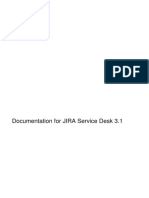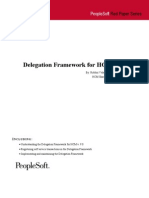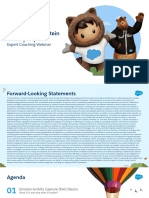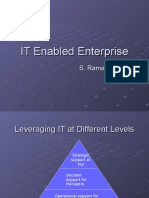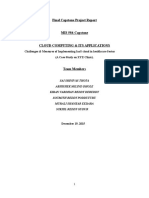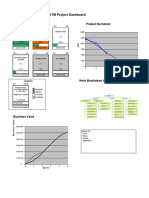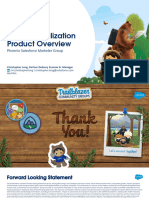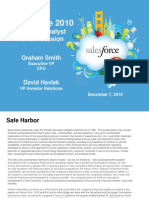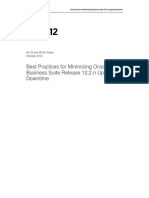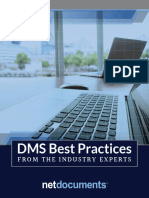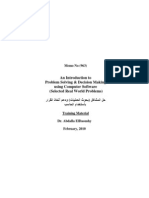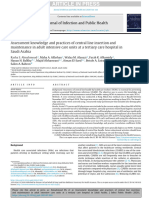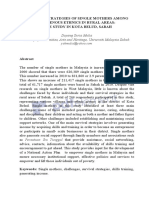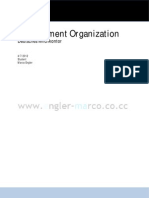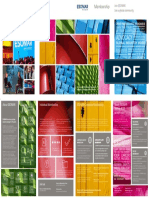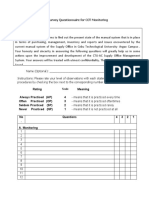Using-TCO Case Study
Uploaded by
shantanu128Using-TCO Case Study
Uploaded by
shantanu128Using Total Cost of Ownership to Determine Optimal PC Refresh Lifecycles
Written for IT decision makers and practitioners across industry verticals who are responsible for managing fleets of laptop and desktop PCs, this paper provides: A total cost of ownership (TCO) assessment framework for optimal PC refresh rates based on Equivalent Annual Cost analysis. The framework takes into account PC acquisition, management, and warranty costs. Analysis of further TCO reduction opportunities offered by Intel vPro technology and a framework to quantify those benefits. Investigation of power savings offered by both optimizing PC refresh rates and by Intel vPro technology.
Accompanying this whitepaper is a Web based return on investment estimator that offers a custom assessment that can be tailored to a specific firms situation. The estimator is available at www.intel.com/business/vpro/roi/demo.htm
Authored by:
Timothy Morey and Roopa Nambiar Wipro Consulting Service Product Strategy and Architecture Practice May 2009
Sponsored by:
Intel Corporation
Copyright Wipro Ltd. 2009. All rights reserved. No portion of this study can be used or reproduced without permission of the author. For additional reproduction rights and usage information, go to www.wipro.com. Information is based on best available resources. Opinions reflect judgement at the time and are subject to change.
Using Total Cost of Ownership to Determine Optimal PC Refresh Lifecycles
Table of ConTenTs
Abstract Table of Contents Executive Summary Introduction Maintenance and Support Costs Increase over Time Cost of Resolving Security Incidents Increase with PC Age Calculating the Optimal PC Refresh Cycle The Added Benefit of Mobility Benefits of Upgrading with Intel vPro Technology What is Intel vPro Technology? What is the Impact of Intel vPro Technology on User Productivity Financial Benefits of Investing in Intel vPro Technology Power Savings Newer PCs Use Less Power Laptop PCs Use Less Power Intel vPro Technology Enabled Remote Shutdown Conclusion and Recommendations Appendix 1: Methodology Data Gathering Data Modeling Power Modeling Assumptions Intel vPro Technology Deployment Cost Assumptions The Model Company Appendix II: Financial Summary of Benefits 1 2 3 5 6 6 8 8 12 12 13 15 16 17 17 18 20 21 21 21 21 21 23 24
page : 2 of 25
Using Total Cost of Ownership to Determine Optimal PC Refresh Lifecycles
exeCuTive summary
When considering ways to stretch IT budgets, it may be tempting to delay PC refreshes and extend PC lifecycles. While this allows firms to avoid PC acquisition costs, older PCs cost more to maintain, so the total cost of ownership (TCO) may actually increase. In order to accurately assess current PC ownership and management costs, Wipro analysts gathered detailed data from 106 firms in North America and Europe including representation from 15 different industries. Each firm had a minimum of 2,500 PCs, of which at least 25% were laptops. The firms all managed elements of PC support with internal IT staff. The data shows that for most firms, the optimal PC refresh lifecycle for both laptop and desktop PCs is three years. The analysis takes into account the cost of PC acquisition, the cost of issue resolution and maintenance based on
$2,500 $2,000 $1,500 $1,000 $500 $0 1 Year Refresh 2 Year Refresh $1,210 $634 $1,926 $716 $1,402 $768 $1,313 $75 $891 $347 3 Year Refresh $1,430 $171 $969 $290 5 Year Refresh
Mobile PC Annual TCO by Refresh Rate (Equivalent Annual Cost)
reported failure rates of PCs at different ages, and out of warranty repair costs. For PCs that are older than three
Out of Warranty Repair Costs Support Costs Acquisition Costs $442 3 Year Refresh $1,266 $824
years, the cost of maintenance and issue resolution increases such that it is cheaper to purchase a new system. The research data demonstrates that support costs increase with age -- a five year old PC costs twice as much to maintain than a new one. One of the maintenance cost drivers is that fact that older systems suffer from more security incidents a four year old PC has 53% more security incidents than a PC in its first year.
FIGURE 1.
For laptop PCs, the optimal refresh rate is three years
Desktop PC Annual TCO by Refresh Rate (Equivalent Annual Cost)
$1,093 $1,000 $433 $800 $600 $400 $200 $0 1 Year Refresh
FIGURE 2.
$811 $740 $465 $499
$755 $26
$802 $59
$660 $346 2 Year Refresh
$539
$585
Out of Warranty Repair Costs Support Costs
$241 3 Year Refresh
Acquisition Costs $189 3 Year Refresh $158 5 Year Refresh
For desktop PCs with an acquisition cost of $600, the optimal refresh rate is three years
page : 3 of 25
Using Total Cost of Ownership to Determine Optimal PC Refresh Lifecycles
Aside from refresh rates, Wipro also assessed the potential impact of upgrading to PCs with Intel vPro technology. Intel vPro technology improves the ability of IT teams to manage systems remotely, even if the PC is turned off or if the operating system is unresponsive. IT technicians can accomplish this by using secure, out of band communication channels enabled by Intel vPro technology. Based on the survey data, Wipro analysts estimate that a firm with 30,800 PCs adopting a cost optimal three year refresh rate will save an additional $2.1 million in maintenance costs over three years by adopting Intel vPro technology-enabled systems. This is the saving after the cost of business and IT process change is accounted for, and most of these savings are driven by a reduction in deskside visits to manually resolve PC issues. Expected per PC savings in this scenario are outlined in Table 1.
Potential Savings/PC/Year
Application Deployment Cost Reduction Patch Deployment Cost Reduction Manual HW Malfunction Resolution Cost Reduction Manual SW Malfunction Resolution Cost Reduction Audit and Inventory Failure Resolution Cost Reduction Security Failure Resolution Cost Reduction Total
TABLE 1.
Laptop PC
$33 $52 $15 $25 $11 $2 $138
Desktop PC
$45 $24 $4 $9 $7 $2 $92
Intel vPro TM technology substantially reduces PC management costs
Firms with large PC fleets are interested in reducing power consumption. Optimizing PC refreshes by retiring older systems and deploying Intel vPro technology-based PCs support this goal. Wipros survey data shows that a firm with 30,800 PCs can reduce power consumption costs by $214,000 a year once they optimize on a three year refresh cycle with Intel vPro technology. This savings is in addition to the maintenance savings outlined above. Expected savings from PC refresh cycle optimization and Intel vPro technology deployment will vary by organization. For instance, the number of PCs, the laptop/desktop mix, age and variety of PC fleet, IT practices, and IT labor costs are examples of metrics that will influence PC TCO. This whitepaper contains typical savings for a firm based on the average values of firms that participated in the study. However, the algorithms and assumptions have been codified into an online estimator at www.intel.com/business/vpro/roi/demo.htm. The online estimator allows finance, IT and operations professionals to tailor TCO analysis to the specific circumstances of their firm, resulting in a more accurate estimate.
page : 4 of 25
Using Total Cost of Ownership to Determine Optimal PC Refresh Lifecycles
inTroduCTion
When faced with cost cutting pressures, IT organizations may consider delaying PC purchases by keeping their existing systems for four, five, or even six years. Delaying PC acquisitions may seem to be an effective way to conserve capital, but when the cost of PC support, maintenance, and user downtime is accounted for the short term savings disappear. When the total cost of ownership is taken into account, delaying PC refresh cycles can turn out to be an expensive mistake. Wipro analysts gathered information from 106 IT organizations in North America, Great Britain, and Germany in March 2009 in order to better understand the costs associated with deploying and maintaining fleets of laptop and desktop PCs. IT practitioners and decision makers with detailed knowledge of their processes and costs each gave Wipro detailed data on PC refresh practices, critical cost drivers, failure rates, PC management practices, power management, and user downtime. Wipro analysts built a financial model based on this information in order to determine optimal PC refresh lifecycles. This whitepaper explores contributing factors that determine the optimal refresh rate for laptop and desktop PCs, using examples from the firms that participated in the survey. There is an online estimator at www.intel.com/business/vpro/roi/demo. htm which uses the same algorithms as those used to derive the analysis in this paper, and allows IT, operations, and finance professionals to build a business case tailored to the unique situation at their respective firms. Aside from the benefits derived from optimizing refresh cycles, this whitepaper also explores
14 12 12 11 9 9 8 5 5 5 4 3 3 3 2 0 8 Number of Respondents
FIGURE 3.
Survey Participant Industries
Professional Services Communication Process Manufacturing Insurance Other Banking Government Healthcare Services Retail Trade Construction Other Financial Services Wholesale Ultilities Transportation Education
the added benefit of refreshing with Intel vPro technology-enabled PCs. Intel vPro technology impacts the cost of PC management and power costs. More issues can be resolved remotely as Intel vPro technology allows IT departments to reach and service PCs, even if they are unresponsive or the operating system is down. IT teams can update PCs remotely with secure power-on capabilities, diagnose and repair distressed PCs, audit and track PCs remotely, and rapidly isolate and fix infected systems. Both this whitepaper and online estimator explore the benefits of optimizing refresh cycles and also calculate the
16
additional benefit of optimizing with Intel vPro technology.
Wipro PSA analysts gathered data from a wide variety of industries in order to understand their PC management cost structures
page : 5 of 25
Using Total Cost of Ownership to Determine Optimal PC Refresh Lifecycles
mainTenanCe and supporT CosTs inCrease over Time
As PCs age, the number of IT issues increases. Wipro gathered data on typical issues that increase the total cost of PC ownership. The key cost drivers are: 1. Updating PCs Typical activities include: a. New application deployments b. Service pack deployment c. Patch or minor updates d. Scheduled security patches e Emergency security patches 2. Diagnosis and repair of PCs Help desk support for major hardware and software malfunctions 3. Security Incidents Isolation and recovery of infected PCs, including: a. Attempted host infection by virus, Trojan Horse or other malicious attacks b. Accidental mis-configuration of management agents c. Intentional/malicious mis-configuration of management agents d. Network or other Denial of Service attacks On average, the routine task of updating PCs is the greatest cost driver. Failures related to PC updates are very common across the PC user base, and manual resolution of these issues can be time consuming and costly. The average costs in North America, UK, and Germany for both laptop and desktop PCs are outlined in Figures 5 and 6. The data shows that there is an increase in costs as systems age.
Cost of resolving security incidents increase with pC age
A typical PC experiences 30 security incidents in its first year, and this climbs steadily as systems age. Moreover, survey respondents report that it requires more effort from more senior IT staff to recover older infected PCs. As a result, resolving security issues in a new PC costs half as much as that of a five year old system. While old and new PCs are vulnerable to virus and spyware, older systems have been around longer, increasing the opportunity for exposure. Once infected, older systems often require costly staff with higher levels of expertise to fix them, especially if the firm has a high level of variety and complexity in its PC fleet (see Wipro whitepaper New Insights on PC Management: Benefits of Controlled PC Hardware Diversity). Analysis shows that PC infrastructure complexity increases with longer refresh cycles. Wipro analysts believe that this may cause enterprises to qualify a smaller percentage of hardware configurations when rolling out software (like security patches), resulting in higher deployment failures rates. These software deployment failures have a tendency to occur with older hardware configurations that are overlooked in the qualification process. Wipro analysts found that viruses and denial of service or other network attacks were the most frequent form of security incident.
Average Annual Cost of Isolating and Recovering Infected PCs (per mobile PC)
$54 $50 $40 $30 $20 $10 $0 Year 1 Year 2 Year 3 Year 4 Year 5 Year 6+ $28 $32 $38 $46
$24
FIGURE 4.
As systems age, there is an increase in the cost of resolving security incidents per system per year
page : 6 of 25 24
Using Total Cost of Ownership to Determine Optimal PC Refresh Lifecycles
For both laptop and desktop PCs, survey respondents reported an average increase in support costs of 59% between the first and fourth years of PC operation. As systems age, they become more costly to update as newer software faces compatibility issues with older systems. Several factors contribute to this rise in PC support costs. First, older PCs accumulate more software which impairs PC performance over time. This can be due to users downloading unauthorized and non-standard applications, which impair or interfere with the performance of corporate applications. It is also the result of complexity that results from the reported 35 scheduled patches and application installs per year for laptops and 51 for desktopsi. Systems that are five or six years old may not have enough RAM to run current versions of some software packages. There is also an increase in security incidents (see Security Incidents Increase with PC Age sidebar for details).
Average Annual Per PC Cost of Supporting Mobile PCs
$1,623 $1,500 $1,200 $900 $600 $300 $0 Year 1 Year 2 Year 3 Year 4 Year 5 Year 6+ $825 $953 $1,136 $1,368
$716
FIGURE 5.
In its 5th year of use, a laptop PC costs twice as much to manage as it did in its first year
Average Annual Per PC Cost of Supporting Desktop PCs
$1,200 $956 $900 $600 $300 $0 Year 1 Year 2 Year 3 Year 4 Year 5 Year 6+ $500 $577 $688 $816
$433
FIGURE 6.
While desktop support costs are lower than laptop PCs, they show a similar increase in management costs over time
page : 7 of 25
Using Total Cost of Ownership to Determine Optimal PC Refresh Lifecycles
CalCulaTing The opTimal pC refresh CyCle
The cost data shows that due to rising support and maintenance costs there is a point where purchasing a new PC is cheaper than maintaining an old one. Wipro analysts selected Equivalent Annual Cost (EAC) as the best decision making framework to assess optimal refresh cycles for PCs. Most investment decisions involve choosing the best investment option in order to provide the greatest return to the firm. Finance professionals have developed investment decision frameworks to make informed choices on which projects to invest in, often using Net Present Value (NPV) calculations. However, PC purchases are not usually a question of whether to buy PCs, but rather how frequently to buy them. Straightforward NPV calculations are adequate for many investment decisions, but for PC refresh cycles where different life-spans are being considered, equivalent annual cost is a better tool. Whereas NPV should not be used to compare projects with different life-spans, EAC quantifies the cost per year of owning and operating a PC over its entire lifespan, and can be used to compare multiple refresh cycle options. By dividing the NPV of a project by an annuity factor, EAC allows IT departments to assess whether a two, three, four, or five year refresh cycle is cost optimal for their business.
The added benefit of mobility
75% of the companies who participated in the 2009 Wipro PC Management survey claim that the number of workers using mobile rather than desktop PCs is increasing. There are several factors for this. Firstly, mobile PCs are allocated based on role, and more and more roles are being defined as requiring mobile PCs. 58% of the companies cited this as a driver of mobile PC adoption. The composition of the workforce is also changing because remote collaboration tools increase tele-work and the use of home offices are increasing. 13% of companies cited the expansion of tele-work programs as a driver for mobile PC adoption, and 28% cited the increase in homeoffice workers. Just 13% of firms have implemented an all-mobile PC policy, but Wipro analysts expect this number to increase over time.
FIGURE 7.
Desktop to Laptop Migration Plans
We do not have any desktop to laptop migration plans in place Mobile PCs are allocated based on role, and more roles are being classified as eligible for mobile PCs Our company is encouraging home-office use, and we are encouraging employees to work from home, hence we are increasing the use of mobile PCs We are allocating mobile PCs to all employees as ageneral rule 0% 13% 25% 58% 28%
20%
40%
60%
75% of firms see some increase in mobile PC allocation
page : 8 of 25
Using Total Cost of Ownership to Determine Optimal PC Refresh Lifecycles
Wipro has therefore adopted EAC as the framework for analyzing the optimal refresh cycle for PCs. This model provides the following key benefits: Expresses PC cost dynamics in a clear and understandable way Offers the flexibility necessary to perform what-if and sensitivity analysis and change assumptions about costs to view their effects on overall TCO Offers a way to compare different time horizons
In this study, Wipro analysts use EAC to compare the cost of a one, two, three, four, and five year PC lifecycle. EAC provides a way to assess the cash flows associated with purchasing and maintaining a fleet of PCs with different lifecycles over a specific period of timeii. Outlined below is a table of costs associated with buying and owning PCs. Note that only the acquisition, support and Out of Warranty support costs are factored into these calculations. Additional costs incurred with older PCs, such as replacement batteries and docking stations are not factored in. Likewise energy costs and the impact of lost user productivity are excluded from this analysis. The focus is purely on the PC cost items which commonly accrue to the IT budget, namely the cost to buy and maintain PCs.
Cash Flows for Laptop PCs Item
Acquisition Cost Support Costs Out of Warranty Repair Costs
Year 1
$1,100 $716 $0
Year 2
$0 $825 $0
Year 3
$0 $953 $0
Year 4
$0 $1,136 $348
Year 5
$0 $1,368 $661
Cash Flows for Desktop PCs Item
Acquisition Cost Support Costs Out of Warranty Repair Costs
Year 1
$600 $433 $0
Year 2
$0 $500 $0
Year 3
$0 $577 $0
Year 4
$0 $688 $120
Year 5
$0 $816 $230
TABLE 2.
Nominal costs of PC acquisition, management and warranty repair costs
page : 9 of 25
Using Total Cost of Ownership to Determine Optimal PC Refresh Lifecycles
To convert cash flows to EAC values, first convert the costs into present values in order to account for the time value of money and then divide that by an annuity factor. An EAC is simply an annuity that has the same life and present value as the underlying cost stream. It allows sets of uneven cash flows to be converted into smooth, regular cash flows that can be compared in a valid way. The calculation is quite simple it is the present value of the support costs over the lifetime of the PC plus the PC acquisition cost, divided by an annuity factor, which is related to the number of years you own the asset. In this example, we are assuming a discount rate of 10%, so the one year refresh annuity factor is 0.91, two year fresh annuity factor is 1.74, the three year is 2.49 and so oniii. Equivalent Annual Cost Values for Laptop PCs Cost Item 1 Year 2 Year 3 Year 4 Year 5 Year Refresh Refresh Refresh Refresh Refresh
$1210 $716 $0 $1926 $634 $768 $0 $1402 $442 $824 $0 $1266 $347 $891 $75 $1313 $290 $969 $171 $1430
Acquisition Cost Support Costs Out of Warranty Repair Costs Total
Equivalent Annual Costs for Desktop PCs Cost Item 1 Year 2 Year 3 Year 4 Year 5 Year Refresh Refresh Refresh Refresh Refresh
$660 $433 $0 $1093
TABLE 3.
Acquisition Cost Support Costs Out of Warranty Repair Costs Total
$346 $465 $0 $811
$241 $499 $0 $740
$189 $539 $26 $755
$158 $585 $59 $802
Equivalent Annual Cost is calculated by dividing the present value of the cash flow with an annuity factor
For the companies interviewed by Wipro analysts in this study, the cost optimal period to own a laptop PC is three years. If a firm were to keep a PC for just one year, support costs are low, but the PC purchase cost makes the total cost of ownership expensive at $1,926 per year. If the same firm were to keep their PCs for two years, the total cost would be $2,804 over two years, or $1,402 per year. While support costs have increased somewhat, the fact that the firm can amortize the PC acquisition cost over two years significantly lowers the equivalent annual cost. The same holds true for the third year. If a firm were to keep its laptop PCs for four years, even though the PC acquisition cost is divided over the four-year period, support and warranty costs increase to a point where the equivalent annual cost is actually $47 higher than if they kept the machines for just three years. Five year and longer lifecycles see a corresponding increase in the cost of ownership and a higher equivalent annual cost.
page : 10 of 25
Using Total Cost of Ownership to Determine Optimal PC Refresh Lifecycles
A similar pattern holds true for desktops. A three-year refresh cycle shows the lowest total cost of ownership as support and out of warranty repair costs increase in years four and five to such an extent that they outweigh the benefit of amortizing the acquisition cost over more years. This study demonstrates that a threeyear refresh cycle is cost optimal for both laptop and desktop PCs, resulting in substantial cost savings over the alternatives. For the Model Company based on the average reported maintenance costs for survey participants, the payback period for moving to a three year refresh would be 15 months for laptop PCs and 17 months for desktop PCs (assuming the Laptop and desktop PCs cost $600 and $1,150 respectively).
$800 $600 $400 $200 $1,000 $500 $0 $2,500 $2,000 $1,500 $1,000
Mobile PC Annual TCO by Refresh Rate (Equivalent Annual Cost)
$1,926 $716 $1,402 $768 $1,210 $634 1 Year Refresh 2 Year Refresh $1,313 $75 $891 $347 3 Year Refresh $1,430 $171 $969 $290 5 Year Refresh
$1,266 $824
Out of Warranty Repair Costs Support Costs Acquisition Costs
$442 3 Year Refresh
FIGURE 1.
For laptop PCs, the optimal refresh rate is three years
Desktop PC Annual TCO by Refresh Rate (Equivalent Annual Cost)
$1,093 $433 $811 $740 $465 $499 $660 $346 1 Year Refresh 2 Year Refresh $539 $585 Out of Warranty Repair Costs Support Costs
$755 $26
$802 $59
Payback Period (in months)
17.0 16.5 16.0 15.5 15.0 14.5 14.0 Mobile PC
FIGURE 8.
$241 3 Year Refresh
Acquisition Costs $189 3 Year Refresh $158 5 Year Refresh
$0
16.9
FIGURE 2.
For desktop PCs with an acquisition cost of $600, the optimal refresh rate is three years
15.3
Refresh without Intel vPro Technology (Mobile PC @ $1,100, Desktop PC @ $600) Desktop PC
The savings from reduced support costs and avoided out of warranty repair costs allow the model company to quickly recover the acquisition
page : 11 of 25
Using Total Cost of Ownership to Determine Optimal PC Refresh Lifecycles
benefiTs of upgrading wiTh inTel vpro TeChnology
Optimizing PC refresh cycles to lower equivalent annual cost has clear benefits as outlined above. IT departments can further lower the cost of ownership by investing in PCs with Intel vPro technology. While the extent of the savings vary by company, for the Model Company based on the results of our survey, switching over to Intel vPro technology on a three-year PC refresh cycle saves an additional $2.1M over three years for the firm. Wipro Consulting Services Product Strategy and Architecture practice has previously conducted multiple studies on the benefits of Intel vPro technology in enterprise IT and IT outsourcer settings (see The Benefits of Intel Centrino 2 with vPro Technology in the Enterprise, available for download at intel.com/vpro). These studies are based upon primary research gathered through more than 200 interviews with IT practitioners in companies of various sizes from a spectrum of industries. The findings on the impact of Intel vPro technologies in these previous studies was projected onto the current PC refresh study in order to assess additional benefits that may be derived by refreshing on Intel vPro technology-enabled systems.
what is the impact of intel vpro Technology on user productivity?
Reducing user downtime should increase user productivity. However, not every hour of PC downtime equates to an hour of lost productivity, as workers may do non-PC related tasks or work longer hours. In order to quantify typical impacts of IT downtime, Wipro analysts asked survey respondents what users do if PC issues mean they cant work while IT is fixing their systems. Answers fell into three different categories: 1. Some workers produce less work output but work the same number of hours. If Intel vPro technology reduces downtime this maps to better productivity and additional work produced. 2. Some workers work more hours to get their job done, and charge their company overtime. If Intel vPro technology reduces the downtime of these workers, it saves the company money. 3. Some workers simply work more hours but dont charge their company overtime. Reducing PC downtime has no direct financial benefit for the company, but the workers get to enjoy more free time and maintain a better life-work balance. Wipro analysts also asked respondents average pay for knowledge, structured task, and data entry workers. In the ROI Estimator tool, salary is used as a proxy for the value of the output. Clearly this understates the value of worker output, as employees in profitable firms produce more value than their cost, but salary is information that survey respondents can answer accurately hence it is the best proxy for value.
page : 12 of 25
Using Total Cost of Ownership to Determine Optimal PC Refresh Lifecycles
whaT is inTel vpro TeChnology?
Intel vPro technology can reduce the cost of PC management and lower power consumption costs. The benefits are as follows: update pCs securely with remote power-on capabilities for better power management and faster software deployments Intel vPro technology provides a reliable, more secure encrypted communication tunnel for remote power control of PCs, using Advanced Encryption Standard 128-bit encryption and Transport Layer Security. Application and patch deploymentsincluding security updatesoccur more rapidly, with dramatically reduced times for recovery from failed deployments. Reductions are attributable to simplification of problem diagnosis, elimination of most desk side visits, and fewer failed deployments due to misidentification of target systems.
Type of Worker
Work Same Hours, Work More Hours, Produce Less Charge Overtime
48% 41% 49% 23% 40% 37%
Work Longer Hours
29% 19% 14%
Hourly Cost
62.24 39.59 28.33
Knowledge Worker Structured Task Worker Knowledge Worker
TABLE 4.
Workers react differently to PC downtime, but on average 80% of PC downtime incidents have a user productivity cost
On average, we found that 80% of downtime has some productivity impact on the firm across worker categories. There was some variation by industry, region and type of worker financial services workers were most likely to absorb downtime by working longer hours, European workers were more likely to work overtime, and data entry workers were the least likely to absorb the downtime by working longer hours but the differences were relatively small. Avoiding user downtime with Intel vPro technology benefits the model company with 30,800 PCs by $23.8M a year in avoided overtime costs, and $21.7M in additional work produced (see Table 4 for hourly costs by worker type). If we take the avoided overtime cost as being the most tangible productivity benefit and apply it to the business case, Intel vPro technology-enabled PCs have a payback period of less than 10 months. The Model Company can recoup the acquisition cost of a Mobile PC (modeled at $1100) in 9.4 months, and Desktop PC (modeled at $750 to account for the higher cost of Intel vPro technology-enabled Desktop PCs) in 7.2 months.
page : 13 of 25
Using Total Cost of Ownership to Determine Optimal PC Refresh Lifecycles
improved ability to diagnose and repair pCs remotely Intel vPro technology allows IT to remotely access a PC even when the operating system is unresponsive and the system will not boot. IT can test the system from a remote management console, and take remedial action (including ordering a new PC in the event the system is un-repairable) without time-consuming desk side visits or user intervention. discover pC assets remotely Whether or not they are powered on, it is easier to correctly identify PCs with Intel vPro technology. This can result in a net reduction of inventory failures, audit failures, re-counts, and misidentification of assets. Based on Wipro research, up to 70% of this remedial work of manually inventorying PCs can be eliminated with an installed base of Intel vPro technology processor enabled laptops.
isolate and recover infected pCs Often the best response to security incidents such as worms or virus attacks is the swift reconfiguration of ports and network connectivity by management software, allowing IT to isolate the infected PCs off the network yet still have a back-channel to remotely fix the quarantined PCs. Intel vPro technology can make IT personnel more responsive by virtually eliminating the cases where manual effort is required to achieve reconfiguration. In addition, by deploying security updates more promptly with Intel vPro technology-enabled tools, IT managers can minimize the time it takes to close any windows of vulnerability.
In translating these benefits to cost reduction, Wipro asked the survey respondents to provide time and effort estimates for problem resolution techniques. Wipro analysts collected data on four techniques commonly used for solving user problems: User assisted via phone User assisted down the wire with remote management tools User ships or delivers PC to IT service depot Desk side visit by IT
Each technique for resolution requires some degree of IT planning and labor, but with Intel vPro technology, time and effort is reduced for the last two of these techniques shipped laptops to IT and desk side visit. The effort reductions are significant for both of these techniques.
page : 14 of 25
Using Total Cost of Ownership to Determine Optimal PC Refresh Lifecycles
finanCial benefiTs of invesTing in inTel vpro TeChnology
In order to quantify the savings achievable from Intel vPro technology, Wipro analysts created a model company derived by averaging the survey responses from all survey participants. The hypothetical firm has 11,500 laptop PCs and 19,300 desktops. Around 20% of the laptop PCs and 19% of the desktop PCs in the model company are older than three years. The model company is fairly disciplined in its purchase of PCs, and restricts itself to five laptop PC and five desktop models per year, limiting the complexity of its fleet. On its existing rolling refresh, the model company intends to get to a point where 60% of its laptop PCs and 50% of its desktops are Intel vPro technology-based systems. Note that this is a fairly conservative end-state; many companies aim for 85%+ of their systems to be Intel vPro technology enabled. The model company saves a total of $3M by moving to a refresh rate of three years. This saving is calculated on the basis of desktop PCs costing $600, and assumes that none of the PCs are Intel vPro technology enabled.
Number of Laptop PC Models Deployed Per Year 5
Model Company Overview
Laptop PCs Number of Laptop PCs 11500
What is the benefit if the model company refreshes with Intel vPro technologyenabled systems instead? Intel vPro technology-enabled desktop PCs tend to be higher end systems so in this calculation Wipro analysts assumed a higher acquisition cost of $750. Laptops are calculated at a constant price of $1150. The benefit of moving to a three-year refresh, shown in Figure 9, drops to $2.1M over a three-year period due to the higher acquisition cost. However, the lowered support and maintenance cost of the fleet due to better remote management through Intel vPro technology provides an additional saving of $3M. Overall, the model company can expect to save $5.1M by moving to a three-year refresh cycle with Intel vPro systems compared with $3M of savings with a three-year refresh cycle without the Intel vPro technology.
Desktop PCs Number of Desktop PCs Number of Desktop PC Models Deployed Per Year IT Sta Costs (U.S. Dollars) Average Annual Burden Rate Per Level 1 Support Sta Average Annual Burden Rate Per Level 2 Support Sta Average Annual Burden Rate Per Level 3 Support Sta $75,844 $92,632 $130,673 19300 5
TABLE 5.
Model company assumptions used in the Intel vPro TM technology benefits calculation. The model company is a fictitious entity derived by averaging the 106 survey responses
page : 15 of 25
Using Total Cost of Ownership to Determine Optimal PC Refresh Lifecycles
The assumptions for this scenario are that only 60% of the laptop fleet and 50% of the desktop fleet will migrate to Intel vPro technology enabled. Increasing the percentage of PCs that move to Intel vPro technology sees a corresponding increase in remote management savings. Moreover, these savings only account for the hard dollar savings in IT management costs that positively impact the IT budget, and does not include the additional benefits from reduced power consumption and increased end-user productivity.
$6,000,000 $5,000,000 $4,000,000
Model Company: Total Bene ts of a 3 Year PC Refresh with Intel vPro Technology
$3,106,597 $3,000,000 $2,000,000 $1,000,000 $0
Benefits of a 3 year PC refresh without Intel vPro Technology (Desktop PCs priced at $600) Benefits of a 3 year PC refresh with Intel vPro Technology (Desktop PCs priced at $750)
Benefits of Intel vPro Technology Benefits of a 3 year PC refresh
$3,053,706 $2,089,841
FIGURE 9.
Support cost decreases more than offset the higher acquisition cost of Intel vProTM technology-enabled PCs
power savings
Recent Wipro studies show that most firms have power savings initiatives in place in order to lower costs, meet government regulations, and reduce the environmental impact of business operationsiv. Optimizing PC refresh cycles while tapping into the new capabilities offered by Intel vPro technology will further enable organizations to reduce power consumption. Newer PCs use significantly less power because of improved processor efficiency Laptop PCs use less power than desktop PCs Intel vPro technology offers the ability to remotely shut down PCs at the end of the workday and to when not in use, without requiring changes in user behavior. The ROI Estimator tool allows IT and finance professionals to calculate both the potential power savings from switching to newer PCs and the savings generated by remote shutdown. Both use cases are explored below but are kept separate from the maintenance and acquisition refresh story as IT departments are not usually responsible for power bills in their firms. For smaller businesses and for users assessing the total financial impact of PC refresh optimization of their firms, the savings are outlined in the results section of the tool. remotely boot them up for patching and servicing. Systems that were previously left running can be turned off
page : 16 of 25
Using Total Cost of Ownership to Determine Optimal PC Refresh Lifecycles
newer pCs use less power
New generations of Intel processors, such as the Intel Core 2 Duo Processor E8500, use around half the energy of older processors, such as the Intel Pentium 4 Processor 630, when they are in active mode.
Processor
Intel Pentium 4 Processor 630
110.18 watts 69.60 watts 3.90 watts 2.50 watts
Intel Core2 Duo Processor E8500
66.11 watts 51.30 watts 2.80 watts 1.50 watts
Energy Use When Active Energy Use When Idle Energy Use in Sleep Mode Energy Use When Off
TABLE 6.
When active and in use, newer Intel PC processors use half the power of older processors
There is therefore an incremental benefit to more frequent PC refreshes, as firms benefit from lower energy consumption of newer PCs in their fleet. While this saving in itself does not justify a more frequent refresh, for the model company it contributes to the value generated from adopting a three-year PC refresh strategy. For the model company with 11,500 laptop PCs and 19,300 desktop PCs, moving to a three year refresh cycle saves the firm $84,000 in energy consumption per year (assumes the current PC fleet age as outlined in the appendix, power costs of $0.1 per KWH, and desktop users running their systems for 7 hours per day, leaving their systems idle for the remaining 17 hours per day).
laptop pCs use less power
Laptop PCs have been optimized for energy efficient performance; hence companies switching users from desktop to laptop PCs can reap significant power savings. 75% of firms surveyed had some sort of initiative in place to increase the number of workers with laptop PCs (see The Added Benefit of Mobility sidebar for details). Depending on the current state of desktop PC power management and the scale of users moving to laptops, these savings can be substantial and help to offset the additional cost of acquiring laptop PCs. The Model Company currently has 19,300 desktop and 11,500 laptop users. Based on the age of the fleet, and assuming that desktops are left on in the idle state overnight for servicing, Wipro analysts estimate that the firm pays $1,162,000 a year in power for the PC fleet. If the Model Company decided to move 95% of its current desktop users to laptops, the estimated annual power costs would fall to $463,000, saving the firm $699,000 per year. On a per system basis the power consumption falls from $37 per system per year to a modest $15 per system per year. Note that these calculations are conservative in the desktop power consumption assumptions previous Intel studies show that firms using unmanaged PCs with cathode ray tube monitors and other energy consuming peripherals consume considerably higher powerv, often in the $50-100 per desktop per year range.
page : 17 of 25
Using Total Cost of Ownership to Determine Optimal PC Refresh Lifecycles
Annual Estimated Energy Cost
Current State Total Estimated Power Consumption Today Future State Future Power Consumption with 95% Switch to Laptop PCs Savings From Moving to Laptop PCs
TABLE 7.
Total
$ 1,162,057 $ 463,259 $ 698,798
The Model Company saves on energy expenses by moving users from desktop PCs to laptops
intel vpro Technology enabled remote shutdown
Despite the efforts by many businesses to reduce their energy consumption and carbon footprint, recent studies have shown that 50% of adults employed in the US who use desktop PCs at work do not shut them off at the end of the dayvi. This can stem several factors, including: Legacy IT policies to leave systems on overnight for patching and repair PC User confusion about the differences among shutting down, standing by, hibernating, and screen saving (only shutdown and sleep/hibernate reduce power consumption significantly).
PCs with Intel vPro technology can be remotely turned on, patched, and switched off again. This capability reduces the need to leave systems on overnight for patching and has emerged as one of the most common use cases for Intel vPro technology. In order to illustrate this benefit, consider the case of the model company. It has a fleet of 11,500 laptop PCs and 19,300 desktop PCs. Laptop PCs are excluded from these calculations as they are often shutdown and taken home or locked away at the end of the day. Wipro analysts assumed that currently users keep their PCs in active mode for seven hours per day, and leave their systems on in the idle state for the remaining 17 hours of a workday, and 48 hours over the weekend. Users do not turn their systems off. If the model company pays $0.1 per KWH, its current desktop PC power consumption is $990,000 per year. Once the firm has switched over to Intel vPro technology-enabled systems on a three-year refresh cycle, IT can remotely shut down systems even if users leave them on, reducing the power consumption to $776,000 per year, a saving of $214,000 per year, a saving of $11 per desktop per year.
page : 18 of 25
Using Total Cost of Ownership to Determine Optimal PC Refresh Lifecycles
Annual Estimated Energy Cost and Energy Savings
Total Annual Energy Cost of Desktop PCs without a 3 Year Refresh or Intel vPro Technology Total Annual Energy Cost of Desktop PCs with a 3 Year Refresh Total Annual Energy Cost of Desktop PCs with a 3 Year Refresh and Intel vPro Technology
Total
$990,000 $915,000 $776,000
Total Annual Energy Savings with a 3 Year Refresh Total Annual Energy Savings with a 3 Year Refresh AND Intel vPro Technology
TABLE 8.
$ 75,000 $ 214,000
Power savings from remote shutdown with Intel vPro TM Technology
In addition to power savings, many utilities offer rebate programs to encourage the adoption of energy efficient PCs. While programs vary from country to country, and by individual utility, Wipro analysts found several programs offering up to $15 off the purchase of specific PC models. The online ROI estimator can accommodate these rebates in the advanced settings tab by lowering the purchase price of the PC to include this rebate.
page : 19 of 25
Using Total Cost of Ownership to Determine Optimal PC Refresh Lifecycles
ConClusion and reCommendaTions
When considering approaches to stretching IT budgets, one regular candidate for saving money is to delay or even stop PC refreshes for a certain period of time. While this approach will delay short term expenditures it is ultimately more costly to the organization due to an associated increase in PC management costs. A three year refresh cycle is the most cost effective PC management strategy because it balances up-front capital investment from new PC acquisition with the spike in per PC support costs that often occurs with older PCs. While optimizing refresh cycles, IT organizations should also consider the positive business case associated with deploying Intel vPro technology. This research study has demonstrated that Intel vPro technology reduces overhead IT management costs by reducing the effort of common IT tasks. With Intel vPro technology, organizations can expect to spend less time conducting patch and application deployments, PC inventory audits, and deskside visits to resolve software and hardware malfunctions. In addition, Intel vPro technology will allow IT departments to respond more rapidly to security incidents. An additional benefit to the firm as a whole is an increase in user and IT productivity. Finally, shorter PC lifecycles combined with Intel vPro technology will help companies reduce energy consumption and carbon footprints. As firms take a hard look at energy usage for cost, regulatory, and environmental reasons, reducing PC power consumption becomes an increasingly important consideration. Wipro concludes that an optimized three year PC refresh cycle along with benefits inherent in Intel vPro technology is a winning combination that will contribute to substantial financial, operational and business benefits. Potential savings explored in this paper, as well as the magnitude of savings are summarized in the table below. Item Description Impact on Model Company with 11500 Laptop and 19300 Desktop PCs
$97 per PC over asset lifetime compared to current state (20% of the laptop PCs and 19% of the desktop PCs in the model company are older than three years in current state) $68 per PC over asset lifetime compared to current state (20% of the laptop PCs and 19% of the desktop PCs in the model company are older than three years in current state) $11 per desktop PC per year
Three Year PC Refresh Cycle
Maintenance and out of warranty support costs increase sharply in years 4 and 5; for most firms, three year lifecycles are cost optimal Enhanced remote PC maintenance decreases the cost of manual resolution
Intel vProTM Technology for Cost Optimal Maintenance Intel vProTM Technology for Power Newer PCs Use Less Power
Remote PC management tool significantly lowers desktop PC power costs as systems are remotely powered down New desktop PCs are almost twice as power efficient as systems 3 years and older, when they are in operation Aside from the productivity benefit, moving towards power managed laptops can more than half a typical firms PC power bill
$3 per PC per year
Laptop PCs Use Less Power
$22 per PC per year
TABLE 9.
Summary of savings potential and magnitude
page : 20 of 25
Using Total Cost of Ownership to Determine Optimal PC Refresh Lifecycles
appendix 1: methodology
data gathering
In 2009, Wipro PSA consultants and technical architects surveyed CIOs, IT directors, and senior IT managers at 106 companies with headquarters in North America and Europe. 50% of respondents were from North America, 25% from the United Kingdom, and 25% from Germany. We selected a representative sample of firms which had: At least 5000 PCs for North America and 2500 PCs for Europe At least 25% of the entire fleet were laptop PCs The firms must handle at least some aspects of PC support with internal IT staff (i.e. firms with total outsourcing contracts were excluded)
Wipro PSA selected companies to represent a diversity of industries, management practices, and user distributions. All survey participants are actively involved in the planning and delivery of the management processes discussed in the survey, and have a granular understanding of the costs involved in service delivery. This ensured that all reporting reflected direct, handson experience with actual management practice.
data modeling
Each survey respondent provided roughly 400 data points on current management practices, PC incidents, and costs, as well as data on future intentions. Wipro analysts used the raw data as a basis for calculating the current average costs of PC management, and derived the optimal PC refresh lifecycles for a typical company based on that average data. Power Modeling Assumptions For power savings calculations, Wipro analysts took average power consumption by PC type in 2009, 2008, 2007 and 2006 and calculated the average consumption. The amount of time a PC is powered, idle and off varies by user and firm, and in the ROI Estimator this is a user input. Intel vPro Technology Deployment Cost Assumptions The projected net benefits of deploying PCs with Intel vPro technology were obtained by balancing the one-time and per-PC implementation costs against yearly savings. Since we assume that PCs with Intel vPro technology are phased in via a companys normal refresh process, yearly savings increase as the refresh cycle proceeds.
page : 21 of 25
Using Total Cost of Ownership to Determine Optimal PC Refresh Lifecycles
Both one-time and per-PC implementation costs have been included in our analysis: One-time implementation costs. These costs are incurred in the first year of Intel vPro technology implementation: - Training of IT installation and support staff - Staff / consulting costs associated with re-engineering the IT installation and supporting processes to include Intel vPro technology-specific activities - Engineering costs to integrate Intel vPro technology features and capabilities with an existing inventory, trouble ticketing system, alert/event database(s), etc.
Per-PC implementation costs. These costs are incurred as the PCs are installed: - OEM Intel vPro technology charge additional premium charged by OEMs for Intel vPro technology-based PCs - Configuration cost additional cost of configuring PCs with Intel vPro technology - Inventory cost additional cost to install PCs with Intel vPro technology during an inventory update
It is assumed that there is no additional license charge by Independent Software Vendors for PC management / security software to support PCs with Intel vPro technology, as this support will be included in their normal release updates. However, these assumptions are variable in the online ROI Estimator tool in order to allow users to capture the unique circumstances of their firm. All costs are used consistent in the analysis described in this study for the model company. However, in the online ROI estimator, the default estimate for the cost to redesign business processes to make use of Intel vPro technology capabilities, as well as the cost to qualify and set up items discovered in the business process consulting varies by size of company. This cost includes the cost of integrating Intel vPro technology features and capabilities into the existing trouble ticketing, alert/event database, and inventory tracking systems. The default setting depends on the number of PCs supported as is set as follows: Small organizations with less than 100 PCs incur no process or engineering costs Firms with 100-1000 systems incur a fee of $20,000 Firms with more than 1000 systems incur a fee of $80,000
These settings are all variable and ROI estimator users can adjust this in the advanced settings tab to reflect their firms situation.
page : 22 of 25
Using Total Cost of Ownership to Determine Optimal PC Refresh Lifecycles
The model Company Wipro analysts use the concept of the Model Company to illustrate the benefits of refresh and Intel vPro technology. The model company is a conceptual company built from the 106 survey data responses which Wipro PSA received. It is based on the average respondent with some outliers removed. It does not represent any specific industry or company type. The model company has 11500 laptop PCs and 19,300 desktop PCs with the following age distribution.
Model Company Age Distribution of Mobile PCs
35% 30% 25% 20% 15% 10% 5% 0% Year 1 Year 2 Year 3 Year 4 Year 5 Year 6+ 4% 3% 18% 12% 34% 28% 35% 30% 25% 20% 15% 10% 5% 0%
Model Company Age Distribution of Desktop PCs
33% 29%
19%
11% 4% Year 1 Year 2 Year 3 Year 4 Year 5 3% Year 6+
FIGURE 10. PC age distribution in the model company
Around 20% of the laptop PCs and 19% of the desktop PCs in the model company are older than three years.
page : 23 of 25
Using Total Cost of Ownership to Determine Optimal PC Refresh Lifecycles
appendix ii: financial summary of benefits
Designed as a one-page tear sheet for financial professionals, this page summarizes the key findings on cost-optimal refresh rates. Item Description Impact on Model Company with 11500 Laptop and 19300 Desktop PCs
$97 per PC over asset lifetime compared to current state (20% of the laptop PCs and 19% of the desktop PCs in the model company are older than three years in current state) $68 per PC over asset lifetime compared to current state (20% of the laptop PCs and 19% of the desktop PCs in the model company are older than three years in current state) $11 per desktop PC per year
Three Year PC Refresh Cycle
Maintenance and out of warranty support costs increase sharply in years 4 and 5; for most firms, three year lifecycles are cost optimal Enhanced remote PC maintenance decreases the cost of manual resolution
Intel vProTM Technology for Cost Optimal Maintenance Intel vProTM Technology for Power Newer PCs Use Less Power
Remote PC management tool significantly lowers desktop PC power costs as systems are remotely powered down New desktop PCs are almost twice as power efficient as systems 3 years and older, when they are in operation Aside from the productivity benefit, moving towards power managed laptops can more than half a typical firms PC power bill
$3 per PC per year
Laptop PCs Use Less Power
$22 per PC per year
TABLE 9.
Summary of savings potential and magnitude
page : 24 of 25
Using Total Cost of Ownership to Determine Optimal PC Refresh Lifecycles
This study was commissioned and paid for by Intel Corporation.
i In this instance, Patches include 1) New Business Applications, 2) Service Packs (application, not OS), 3) Patch, software or agent upgrade, 4) Scheduled security patch (application or OS) and 5) Emergency security patch (application or OS). Of these, the average number of scheduled and emergency security patches was more or less the same for mobile and desktop systems. However, survey respondents cite almost twice as many new business application, service pack, and patches for desktop PCs than laptops. This indicates that users load more applications on desktops, which in turn requires more patching. ii Wipro analysts used three years as the period for assessment. A good analogy might be that of measuring the flow of water in a river. Think of the water flowing in the river as the PC acquisition and support costs. If the river is low, water just trickles down the river but if the water level is high, the river is a gushing torrent. In order to measure the flow of water down the river, we need to pick a consistent time frame, be it a minute, hour, or year. The timeframe used is not relevant so long as the time frame is held constant. The resulting measurement shows an accurate comparison of water levels at different times. Likewise with PC costs, EAC shows different levels of cost by different refresh rates. iii EAC (Equivalent Annual Cost) = PV/Annuity Factor, where annuity factor is ((1+r)^n-1)/r*(1+r)^n), where r is the discount rate and n is the year iv A March 2009 study of industrial and manufacturing firms showed that 96% of firms participating in the study had some sort of power saving initiative in place. See Reducing Industrial PC and Embedded System Support Costs with Intel vPro Technology for details. v See Intel Capabilities Forum, Energy Efficient Performance 2.0 for details. http://www.intelcapabilitiesforum.net/EEP-page_all/ vi PC Energy Report 2009, The Alliance to Save Energy (www.ase.org)
page : 25 of 25
You might also like
- Balanced Scorecard For Information Technology Example: Strategy Goal Objective Key Performance Indicators TargetsNo ratings yetBalanced Scorecard For Information Technology Example: Strategy Goal Objective Key Performance Indicators Targets1 page
- Delegation Framework For HCM V. 9.0: Peoplesoft100% (1)Delegation Framework For HCM V. 9.0: Peoplesoft33 pages
- Einstein Activity Capture Webinar GuideNo ratings yetEinstein Activity Capture Webinar Guide23 pages
- Reseller Webinar SERIES 2020: Welcome To TheNo ratings yetReseller Webinar SERIES 2020: Welcome To The26 pages
- Five Key Considerations Enterprise MonitoringNo ratings yetFive Key Considerations Enterprise Monitoring13 pages
- It Rationalize Your Application Portfolio PlaybookNo ratings yetIt Rationalize Your Application Portfolio Playbook11 pages
- MIS 584 Final Capstone Project Report - Group13No ratings yetMIS 584 Final Capstone Project Report - Group1344 pages
- Lou Gerstner On Corporate Reinvention and Values100% (1)Lou Gerstner On Corporate Reinvention and Values7 pages
- Agile Scrum Project Status Report Scrum Template Excel Scrum Project Status Report Scrum Excel Template FreeNo ratings yetAgile Scrum Project Status Report Scrum Template Excel Scrum Project Status Report Scrum Excel Template Free9 pages
- MCP - Day#1 - Marketing Cloud Personalization - Product OverviewNo ratings yetMCP - Day#1 - Marketing Cloud Personalization - Product Overview42 pages
- Competitive Comparison-Application Servers100% (1)Competitive Comparison-Application Servers64 pages
- Service Now Application Product OverviewNo ratings yetService Now Application Product Overview10 pages
- MuleSoft Meetup 16.06.2024 - Frankfurt ChapterNo ratings yetMuleSoft Meetup 16.06.2024 - Frankfurt Chapter40 pages
- PeopleCert Scrum Product Owner I - II - Flyer - Digital - 202211No ratings yetPeopleCert Scrum Product Owner I - II - Flyer - Digital - 2022112 pages
- Azure - Advance Licensing Scenarios and Hybrid Use Rights - SlidesNo ratings yetAzure - Advance Licensing Scenarios and Hybrid Use Rights - Slides51 pages
- Best Practices For Minimizing Oracle EBS R12 2 N Upgrade Downtime Oct 14No ratings yetBest Practices For Minimizing Oracle EBS R12 2 N Upgrade Downtime Oct 1499 pages
- NetDocuments Whitepaper DMS Best PracticesNo ratings yetNetDocuments Whitepaper DMS Best Practices18 pages
- HCL Information Security Practice: Security Transformation System IntegrationNo ratings yetHCL Information Security Practice: Security Transformation System Integration4 pages
- TBMC FoundationEd&CertSyllabus October2016No ratings yetTBMC FoundationEd&CertSyllabus October201615 pages
- Solution Architecture Proposal Requirements Package ShuberNo ratings yetSolution Architecture Proposal Requirements Package Shuber35 pages
- BMC Remedy Knowledge Management 7.2 - Planning and Configuration GuideNo ratings yetBMC Remedy Knowledge Management 7.2 - Planning and Configuration Guide154 pages
- Caching Architecture Guide For .NET ApplicationsNo ratings yetCaching Architecture Guide For .NET Applications150 pages
- PoliSave Efficient Power Management of Campus PCsNo ratings yetPoliSave Efficient Power Management of Campus PCs6 pages
- Dissertation On How Holy Ten Music Helps Fight GBV CHAPTERS FINALNo ratings yetDissertation On How Holy Ten Music Helps Fight GBV CHAPTERS FINAL55 pages
- Competency Mapping Project 360 Degree MethodNo ratings yetCompetency Mapping Project 360 Degree Method108 pages
- "Single Mothers' Survival in Rural Sabah"No ratings yet"Single Mothers' Survival in Rural Sabah"8 pages
- Organizational Behaviour: Submitted To: Mr. A. Srinivasa Rao Associate ProfessorNo ratings yetOrganizational Behaviour: Submitted To: Mr. A. Srinivasa Rao Associate Professor47 pages
- Dr. Yashashwini and Neelima Scopus Paper Publication 1No ratings yetDr. Yashashwini and Neelima Scopus Paper Publication 116 pages
- Survey Questionnaire For OJT Monitoring SystemNo ratings yetSurvey Questionnaire For OJT Monitoring System3 pages


